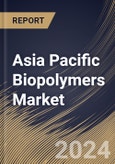They are making inroads into the textile and fashion industries as sustainable alternatives to traditional fabrics. Innovations in bio-based fibers, such as those derived from corn or sugarcane, provide environmentally friendly alternatives for clothing production. Biopolymer-based textiles cater to the growing demand for sustainable and ethically produced fashion. They find applications in the manufacturing of electronics and consumer goods. They can be used for casings, packaging, and components in electronic devices, reducing non-biodegradable waste in the electronics industry. These polymers in consumer goods help companies meet sustainability goals and respond to environmentally conscious consumer preferences.
The construction industry is exploring the use of these polymers in various applications, such as biodegradable packaging for construction materials and sustainable insulation materials. They can contribute to reducing the environmental impact of construction projects and help meet green building standards. They are increasingly used in 3D printing, providing a sustainable alternative to traditional plastics for additive manufacturing. PLA is a popular bio-polymer used in 3D printing due to its biodegradability and ease of processing. This application aligns with the growing interest in eco-friendly 3D printing materials.
China has abundant access to renewable resources, making it conducive to producing bio-based polymers. China actively promotes the circular economy, emphasizing resource efficiency, recycling, and waste reduction. Ongoing research and innovations in biopolymer technology contribute to developing advanced materials with improved properties in China. As a bio-based alternative, these polymers reduce China's dependency on fossil fuels for plastic production. Continuous improvements in bioplastic processing technologies make them more accessible and cost-effective for manufacturers in China. Thus, due to the above-mentioned factors, the market will grow significantly in this region.
The China market dominated the Asia Pacific Biopolymers Market by Country in 2022, and would continue to be a dominant market till 2030; thereby, achieving a market value of $3,545.6 million by 2030. The Japan market is registering a CAGR of 9.7% during (2023 - 2030). Additionally, The India market would showcase a CAGR of 11.2% during (2023 - 2030).
Based on End-use, the market is segmented into Packaging, Consumer Goods, Automotive, Agriculture, and Textiles & Others. Based on Application, the market is segmented into Bottle, Films, Fibers, Seed Coating, Medical Implants, Vehicle Components, and Others. Based on Product, the market is segmented into Biodegradable Polyesters, Bio-PE, Bio-PET, Polylactic Acid (PLA), Polyhydroxyalkanoate (PHA), and Others. Based on countries, the market is segmented into China, Japan, India, South Korea, Singapore, Malaysia, and Rest of Asia Pacific.
List of Key Companies Profiled
- BASF SE
- Archer Daniels Midland Company
- DuPont de Nemours, Inc.
- bio-tec Biologische Naturverpackungen GmbH & Co. KG
- Novamont S.p.A. (Versalis S.p.A.)
- BiologiQ, Inc.
- Ecovia Renewables Inc.
- BioPolymer GmbH & Co KG
- Solanyl Biopolymers Inc.
- Biopolymer Industries
Market Report Segmentation
By End-use (Volume, Kilo Tonnes, USD Billion, 2019-2030)- Packaging
- Consumer Goods
- Automotive
- Agriculture
- Textiles & Others
- Bottle
- Films
- Fibers
- Seed Coating
- Medical Implants
- Vehicle Components
- Others
- Biodegradable Polyesters
- Bio-PE
- Bio-PET
- Polylactic Acid (PLA)
- Polyhydroxyalkanoate (PHA)
- Others
- China
- Japan
- India
- South Korea
- Singapore
- Malaysia
- Rest of Asia Pacific
Table of Contents
Companies Mentioned
- BASF SE
- Archer Daniels Midland Company
- DuPont de Nemours, Inc.
- bio-tec Biologische Naturverpackungen GmbH & Co. KG
- Novamont S.p.A. (Versalis S.p.A.)
- BiologiQ, Inc.
- Ecovia Renewables Inc.
- BioPolymer GmbH & Co KG
- Solanyl Biopolymers Inc.
- Biopolymer Industries








